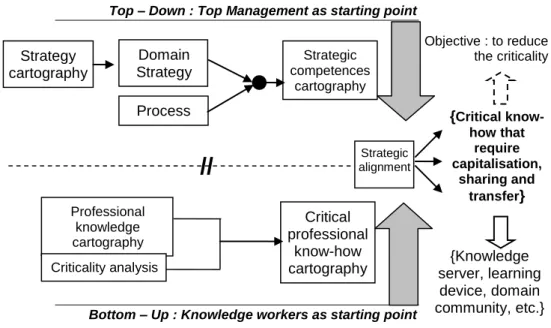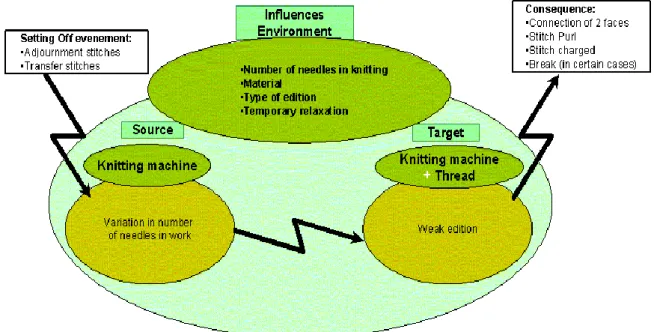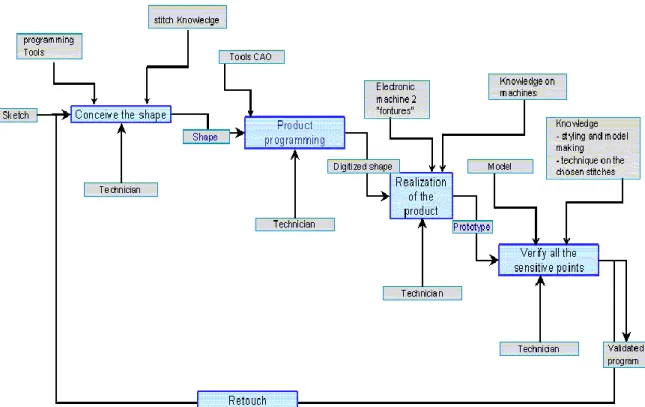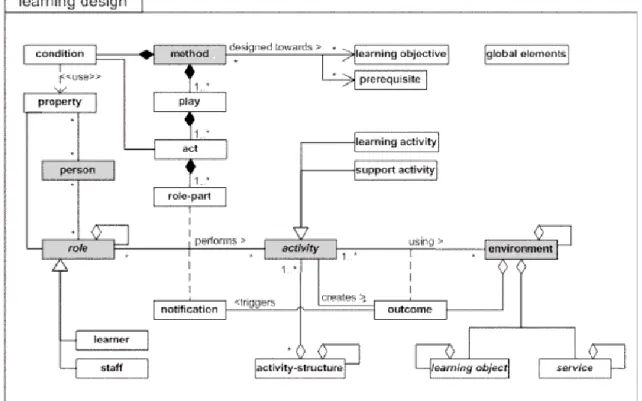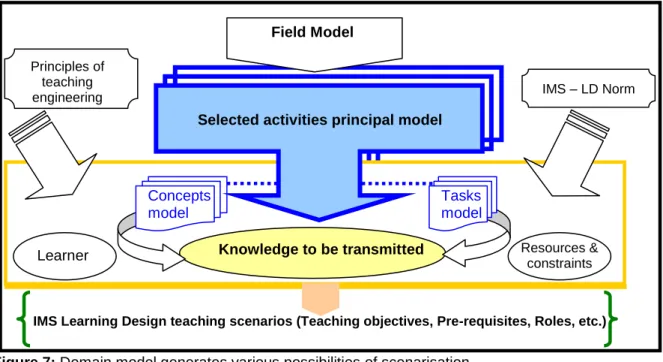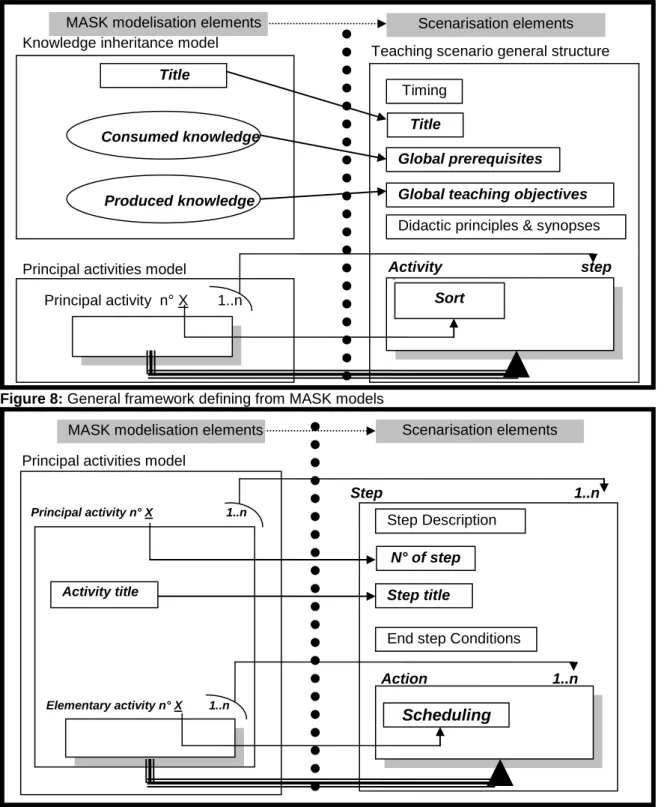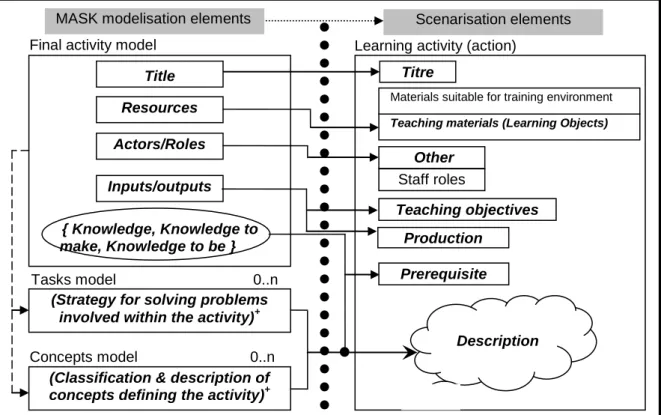HAL Id: hal-00431630
https://hal.archives-ouvertes.fr/hal-00431630
Submitted on 7 Apr 2010
HAL is a multi-disciplinary open access
archive for the deposit and dissemination of
sci-entific research documents, whether they are
pub-lished or not. The documents may come from
teaching and research institutions in France or
abroad, or from public or private research centers.
L’archive ouverte pluridisciplinaire HAL, est
destinée au dépôt et à la diffusion de documents
scientifiques de niveau recherche, publiés ou non,
émanant des établissements d’enseignement et de
recherche français ou étrangers, des laboratoires
publics ou privés.
know-how transfer
Djilali Benmahamed, Jean-Louis Ermine
To cite this version:
Djilali Benmahamed, Jean-Louis Ermine. A knowledge server including tools for professional
know-how transfer.
ECKM 2007 : 8th European Conference on Knowledge Management, Sep 2007,
Barcelona, Spain. pp.108-117. �hal-00431630�
1
A Knowledge Server Including Tools for Professional
Know-How Transfer
Djilali Benmahamed1 & 2, Jean-Louis Ermine1 1
Institut National des Télécommunications, Evry 91011, France
2 Centre de Perfectionnement de l’Entreprise Sonatrach, Oran 31230, Algeria Djilali.benmahamed@int-evry.fr
Jean-louis.ermine@int-evry.fr
ECKM 2007 (European Conference on Knowledge Management), Barcelona, 6-8 septembre 2007
Abstract: This paper presents a research in progress on the use of knowledge engineering and knowledge management techniques for the development of a strategic approach for the transfer of professional know-how. This transfer is based on the design of devices for sharing and learning clearly identified knowledge in the oil industry domains. This work is based on a pilot study which was carried out in the PED department (Petroleum Engineering & Development) and it deals with upstream activity of the oil group Sonatrach. After the different phases of knowledge mapping, critical knowledge assessment, and strategic alignment, the KM process focus on knowledge elicitation, sharing, transfer and learning, based on design and implementation of specific tools called Knowledge Server, including Knowledge Books and e-Learning.
Keywords: Knowledge Management, Knowledge Engineering, Knowledge Servers, Computer Assisted Human learning, e-learning, Case Study.
1. Introduction
In this article, we define elements of strategy and implementation for know-how transfer in the Oil Group Sonatrach1. This research work is based on practical application in the company and is sponsored by Sonatrach.
Sonatrach is the Algerian company for research, exploitation, transport by pipeline, transformation and trading of hydrocarbons and their derivatives. It also operates in other sectors such as electricity production, new and renewable energies and the desalination of sea water. Its activities represent approximately 30% of the GNP in Algeria. It employs more than 120.000 staff and workers.
Sonatrach Top Management has launched the knowledge management project as a strategic project. This Project is thus based on a global vision of the Company (and it is supported by the Top Management) together with local and effective actions aiming at producing noticeable profits in the short run. It aims at preserving the strategic potential of knowledge that has been acquired throughout the years, but which has remained tacit for its holders.
Our research aims first at showing the feasibility of a capitalization strategy and the transfer of know-how in oil industry domains as much as it aims at describing the conditions of success in such environments. The re-use of the strategy as well as of the devices and their deployment for every unit constitutes one of the expectations of the Company.
From a scientific point of view, we try to validate a formal approach of know-how transfer based on strategy and on knowledge management and knowledge engineering techniques. The first result is based on an effective action plan which involves innovating concepts of knowledge management such as strategy maps, knowledge mapping, critical analysis, knowledge engineering, management for community of practice, collaborative work, etc.
Our exploratory study is interested in the operational activities within Sonatrach, particularly the upstream activity (research, exploitation and production of hydrocarbons). It appears to us more valuable to carry out the study of this activity, with respect to the size and complexity of the Company. We have thus decided to confine ourselves to targeted knowledge by selecting a structure which constitutes a nodal point and an inevitable upstream activity, involving strategic and critical know-how. Thus, the PED division (Petroleum Engineering & Development) was selected for the test domain of our study. This research project, within the PED, consists in designing and testing the KM methodology, based on the concepts mentioned above and directed by the strategy in Sonatrach, whose aim is to ensure sharing and transfer of the most critical knowledge.
The phase which is described in details here is the designing, then implementing devices (knowledge servers and computer assisted human learning, e-learning) by capitalizing knowledge with a
1
knowledge engineering method and carrying out, thereafter, a pedagogical observation based on the acquired knowledge models. The groups of learners involved in the learning apparatus presented here, when sharing knowledge will evolve into communities of practice (Wenger 2002).
2. Theoretical foundations of the study
The scientific framework of this study is based essentially on some concepts such as strategy maps (Kaplan 2004), knowledge maps and criticality analysis as developed by the Knowledge Management Club2, strategic alignment of knowledge (Ermine 2005), knowledge modelling as in the MASK method (Ermine 2002) and (Ermine 2003), as well as other knowledge engineering techniques, learning groups and communities of practice (Wenger 2002), modelling of the elements and structures of the various learning units with the help of IMS specification (IMS 2003) as well as the computer assisted human learning environments (Tchounikine 2002), and e-learning.
Our contribution consists of the setting in synergy of the various concepts by integrating them in the same process. We start with strategy and knowledge maps, criticality analysis and strategic alignment of knowledge, in the first step. The result of this first step constitutes an access point for the second. We continued in the second setp, with the use of the knowledge modelling as in the MASK method as well as other knowledge engineering techniques to define contents to be transferred, within the company. Learning groups and communities of practice constitutes a result of this assembly process of these concepts. Modelling of the elements and structures of the various learning units with the help of IMS specification as well as the computer assisted human learning environments and e-learning are the technological supports for the implementation of the contents identified at the end of these previous steps.
Rather to consider disparate devices, which would resemble more panoply of tools than to a concerted process, our step aims at the development of an action plan complete and coherent. This process indicates thus how these concepts can be complementary, once integrated in the same process. The synergy resulting from the interconnection of these concepts during the various stages of our research constitutes the formal and innovating framework of the ongoing study.
3. The first phase: critical knowledge assessment and strategic alignment
The first phase of our study case was to identify the best professional knowledge that is critical regarding the strategy of the company and the vision of the concerned knowledge workers. That phase is described in details in (Benmahamed 2006). Figure 1 summarizes the main steps of the method which, in addition to its strategic dimension, puts the knowledge holders (Knowledge Workers) at the centre of any process of thinking/acting.
The practical work has been carried out on the basis of four steps: group working sessions involving those concerned with discussion on a particular issue, individual interviews with nearly twenty people concerned in various processes (knowledge actors/experts), interviews with managers to explain the strategy and finally readings of reference documents. 80% of the interviewed knowledge actors have an average of 20 years experience in their competences domains with highly qualified professional profiles. The interviews and group working sessions took place at the PED and together with Sonatrach Top Managers. During the interviews, some support tools have been used (such as evaluation grids for criticality, profile cards, recordings, etc.) as well as interviewing techniques. During group working sessions, we used facilitation techniques (brainstorming) and projections (video projector) to help the group to merge their views and ideas for a better knowledge sharing. Once formalised, all the results have been validated with the participants.
2
Figure 1 : Main Steps of the first phase of the project
4. Phase 2: Knowledge Capitalisation and the design of Knowledge Books
The first phase has pointed out chunks of knowledge that are critical and strategic. Among them, a great number remains tacit, within the « brain of the Knowledge Workers ». For this kind of knowledge, this is a very important point of criticality.
To reduce this criticality factor, we have included in our KM process, an elicitation process, with Knowledge Engineering techniques. To test that process, and following the results of phase 1, the chosen domain for knowledge elicitation is the so-called “reservoir engineering” domain. The elicitation method is a knowledge modelling method called MASK (Methodology for Analysing and Structuring Knowledge) (Ermine 2002) and (Ermine 2003), a well tried method, used in a lot of companies, in several countries, presently in its third generation.
4.1 Knowledge modelling
The first result in the MASK method is a set of models representing the knowledge domain, elaborated during interviews with the experts of the domain. This task has been performed with ten experts, with about 150 hours of work, during three month. This set of models has been completed with all important information, documents, files attached to the elicited knowledge. The result is called a “Knowledge Book”, which is the essence of the know-how on the domain “reservoir engineering”, as practiced in the PED division in Sonatrach.
The knowledge representation in MASK is based on graphic presentations. A Knowledge Book, written with the MASK method, can illustrate a professional knowledge. In this book:
Domain knowledge is represented as phenomenon model (Fig 2) and concept tree (Fig 3) Reasoning knowledge is described as process model (Fig 4) and task tree (Fig 5).
Objective : to reduce the criticality {Knowledge server, learning device, domain community, etc.} {Critical know-how that require capitalisation, sharing and transfer}
Bottom – Up : Knowledge workers as starting point Top – Down : Top Management as starting point Strategy cartography Domain Strategy Process Strategic competences cartography Critical professional know-how cartography Professional knowledge cartography Criticality analysis
//
alignment StrategicFigure 2: Example of professional knowledge, phenomenon model, built with the MASK method.
Figure 4: Example of professional knowledge, process model, built with the MASK method
Figure 5: Example of professional knowledge, task model, built with the MASK method
In addition there is a general model to describe precisely the Knowledge Capital we have to work with, and two others models to describe the history and the evolution of the considered knowledge. Each modelling phase is based on interviews with specialised experts, using cognitive techniques. Hence, there is a “co-construction” of the models with the knowledge holders. The collected content is then reviewed to reach some quality standards, and be completed by different information and document sources. A validation phase is finally organised with all the contributing experts.
The Knowledge Book made for the PED expertise has about 200 pages, and index a very important document basis. It has been designed during 6 months, and is now recognised in PED as a real professional reference for reservoir engineering in the PED division. However, a Knowledge Book is
not the final destination of the project. The knowledge encapsulated in it has to be disseminated trough various devices, in order to get the most valuable benefits.
5. e-KBook: an electronic Knowledge Book
The Knowledge Book that has been constructed is the final output of a Knowledge Engineering process. To ensure knowledge dissemination, sharing and enrichment, it has been decided to implement the Knowledge Book in an electronic form, inside the intranet of the company (e-KBook). This required techniques used for hypermedia (Ginige 1995) and (Chaillot 1997). Three dimensions are identified for hypermedia applications (Halasz 1994) and (Grosky 1994):
The content: this is the information to be presented (texts, drawings, diagrams, pictures, videos …)
The browsing network; this is a graph where the nodes are the pieces of information of the content, and the links are the browsing links.
The user interface
The e-KBook proposes different possibilities for exploring knowledge. It helps the user to explore the book from different points of view:
Phenomenon models to understand the physical properties and phenomena for reservoir engineering
The activities decomposition to understand and follow the different processes in reservoir engineering
The interactions between activities and phenomena to understand and master the complexity of reservoir engineering.
e-KBook aims at providing a part of the Knowledge Book to different users, whose profiles may vary depending on the objectives (capitalisation, vulgarisation …)
6. Transforming the Knowledge Book in e-learning for professional knowledge (e-PLearn) 6.1 Introduction
One of the issues for knowledge transfer is evidently training. Knowledge Book aims at capitalizing critical professional how. The question of using that Knowledge Book for transferring that know-how, by training people is then natural. But from capitalizing to learning is nor really evident. So, we are now interested in the construction of learning activities from Knowledge Book, to transfer professional knowledge, a device called e-PLearn.
Learning activities are activities designed to make learners/employees achieve a given set of actions that will help them to internalize knowledge. Constructing such a learning activity requires identifying the scenarios that the employees will have to perform, the different tasks they will have to perform, the different roles to be distributed, etc., and then modelling these different aspects. When the knowledge that is to be learned by the employees is part of the Knowledge Management system of the company, it appears natural to build the learning activities scenarios from the data stored in the Knowledge Book.
We propose to achieve such a process and, more precisely, how we propose to construct learning scenarios from the MASK Knowledge Management methodology and to represent them using the IMS-Learning Design language. We explain the matching between the different MASK models and how the different components of an IMS-LD scenario can be constructed from the Mask models. 6.2 IMS - Learning Design
Learning Design aims at an evolution of e-learning by capturing the “process” of education rather than simply content. By describing sequences of collaborative learning activities, Learning Design offers a new approach to re-use in e-learning (Dalziel 2003). Learning Design has emerged as one of the most significant recent developments in e-learning. From a standards/specifications perspective, IMS Global Learning Consortium has recently released the IMS Learning Design specification (IMS 2004), based on the work of the Open University of the Netherlands (OUNL) on “Educational Modeling Language” (Koper 2001), a notational language to describe a “meta-model” of instructional design. The OUNL coordinates an international EML/IMS Learning Design implementation group known as the Valkenburg group (Tattersall 2003), and OUNL has recently stated their intention to no longer
continue developing EML, but instead focus their energies of the new IMS Learning Design specification.
Three levels of representation suggested by IMS - Learning Design allow specification and implementation of a great diversity of e-learning teaching contents (IMS 2004):
At Level A, Learning Design specifies a time ordered series of activities to be performed by learners and teachers (role), within the context of an environment consisting of learning
objects or services. Analysis of existing design approaches revealed that this was the
common model behind all the different behaviourist, cognitive, and (social) constructivist approaches to learning and instruction. For more advanced learning purposes, properties and
conditions, and notifications are required.
Levels B and C of the Learning Design Specification provide these. Properties, specified at Level B, are needed to store information about a person or a group of persons (role). So for a student its progress may be stored, perhaps in a dossier; for teacher information on papers graded may be stored. Conditions, also part of Level B, constrain the actual evolution of the didactic scenario. They are set in response to specific circumstances, preferences, or the characteristics of specific learners (e.g., prior knowledge). The idea is of course that randomness allows the student to freely explore the materials. Notifications, specified in addition to the properties and conditions of Level B at Level C, are mechanisms to trigger new
activities, based on an event during the learning process. For instance: the teacher is
triggered to answer a question when a question of a student occurs; or the teacher should grade a report, once it has been submitted.
Here we will limit ourselves to the "A" level, i.e., general design of scenario as time ordered activities.
Figure 6: Conceptual model of the overall Learning Design structure (IMS 2004) 6.3 Matching MASK / IMS – LD
6.3.1 Identifying general scenarios
In the initiating phase in a MASK project, we generally use a model, called “Domain Model”, to give the framework and the identified knowledge domain to capitalize. This model proposes a global vision of the modelled knowledge, therefore a starting point that allows identifying the general scenario(s) of the learning activities. The continuation will be the deepening of each element representing a flow and which takes place in this diagram. This process emphasizes the principia based on the perception of a field like a decomposition of phases and each phase can, in its turn, be broken up into other phases
of lower level. The idea is thus to describe the various headings of the teaching scenario by traversing these phases. The total framework will be defined starting from the phenomena model and the succession of the decompositions will give an indication about the granularity level of the teaching scenarisation. So, a phenomena model can provide several scenarios guided by various possible activities principal models (Fig 7).
Figure 7: Domain model generates various possibilities of scenarisation
6.3.2 Defining the scenarios from principal activities model
The general scenario can be further detailed as follows:
The inheritance model allows defining the different scenarios elements, such as global prerequisites, global teaching objectives, etc. and the principal activities model, the different activity steps. (Fig 8)
The general activities model allows making more precise the different activity steps by defining different characteristics such as the step number, the title and in particular the different actions to be scheduled (Fig 9).
The different activity sub-models and their referent tasks models and concept models allow to make more precise the different features of the learning activities such as the different roles, the teaching objectives and the intended production, etc. (Fig 10).
Knowledge to be transmitted
IMS Learning Design teaching scenarios (Teaching objectives, Pre-requisites, Roles, etc.) Principles of
teaching
engineering IMS – LD Norm
Learner s Resources & constraints Concepts model Tasks model Selected activities principal model
Figure 8: General framework defining from MASK models
Figure 9: Steps defining from MASK models Elementary activity n° X 1..n
Principal activities model
N° of step Step title Step Description
End step Conditions
Action 1..n
Scheduling
Principal activity n° X 1..n
Activity title
Scenarisation elements MASK modelisation elements
Step 1..n Title Consumed knowledge Produced knowledge Principal activity n° X 1..n
Knowledge inheritance model
Scenarisation elements
Principal activities model
Timing Title
Global prerequisites Global teaching objectives Didactic principles & synopses MASK modelisation elements
Activity step 1..n
Sort
Figure 10: Activities learning defining from MASK models
As the objective of the learning is to work out accurately a given procedure, the activity can be further detailed using the tasks model of the considered activity (in particular, the task model describes the "expert" problem resolving strategy).
6.3.3 Example of Matching MASK / IMS – LD
Once "Reservoir Engineering" MASK models capitalizing knowledge carried out and validated by the experts (syntax and contents), we applied our matching process as we have defined it. Tab. 1 presents a general learning scenario generated. This general scenario is based on 06 activity steps, each step being then refined into 24 activities. From the standard description of this material can be generated an IMS-LD description as an XML file.
Timing : Depending of the nature of learning
Learning activity general structure for "Reservoir Engineering" Course title: Learning the job “reservoir engineering”.
Global teaching objectives: - …
Global prerequisites: Adaptability to development planning and economic and strategic context, fundamental basis of the job
Didactic principles & synopses:
- alternate individual and collective learning steps
- alternate synchronous and asynchronous learning steps - …
Learning steps (Learning steps references and execution conditions) Réf. Starting
with?
Waiting the end
of learning step Learning step title
Next Learning step
1 Yes / Preparation of the upstream project 2
2 No 1 Project beginning 3
3
No 2 Models construction 4 or 54
No 3 Uncertainty Management 35
No 3 Operating the optimal planning /Learning steps scheduling : developer choice actors choice cf. previous table
Table 1 : general learning scenario generated { Knowledge, Knowledge to
make, Knowledge to be } Final activity model
Scenarisation elements
Titre
Other roles "Learner" Staff roles MASK modelisation elements
Learning activity (action)
Resources Actors/Roles
(Strategy for solving problems involved within the activity)+
(Classification & description of concepts defining the activity)+ Tasks model 0..n
Concepts model 0..n
Teaching materials (Learning Objects)
Materials suitable for training environment Title Prerequisite Description Teaching objectives Inputs/outputs Production
The constant of the learning scenario from the MASK models can be characterized as follows by: The obtained scenario covers the key knowledge as that in the MASK models.
Training process features (staff roles, durations of the meetings, environment materials, etc.) that are not taken into account at the time of MASK modelling.
A difficult aspect of the translation is the definition of the level of granularity: MASK Models constitute "a block" of knowledge distributed on the various levels and models. In order to keep intact the direction of the knowledge-making, we had the constraint to adopt the same levels of granularity and decomposition.
Some elements of the teaching scenario cannot be directly picked in the given MASK model but can be extracted from a combination from models. As an example, the description of the Learning activity requires elements "Knowledge-to make" and "Knowledge-to be" aspects corresponding model of the activity, descriptions of the tasks models and those of concepts models y referent.
This work of definition of contents, design and scenarisation is intended to the actors of the field through a Computer Environment for the Human Training (CEHT), standard E-Learning and described in IMS - LD. That thus requires additional work to reinforce the assets of such a passage and to answer the difficulties and/or lacks recorded at the time of the passage. For that, we propose for future developments:
The expert can be called, during the interviews, to indicate some elements which it consider essential so that one learning can comparable its mode of reasoning and/or its way of resolution of problems, in order to include it in the e-Plearn device.
To exploit the book of knowledge rather than the simple MASK models. The Knowledge Book is, in fact, the "real" production of the method MASK and which includes the models. The Knowledge Book has the advantage, compared to the models, to be content of complementary descriptions which answer the lacks that one noted theoretically and confirmed by our passage experimentation.
6.3.4 Quiz for evaluation
With the use of the phenomenon models, quizzes have been done as questionnaires. Those quizzes are tools for (Greco 2004):
Validate the acquired knowledge, by question oriented by the objectives in Learning. This is “sommative evaluation”. It has been use to define the learner’s level and prose appropriate scenario.
Verify the progression of the learner, versus the objective and the predefined program. This is the “formative evaluation”. This is used in e-PLearn as exercises in limited time, and with commented answers, in order to be used as an auto-evaluation tool.
This was implemented by using the freeware « HotPotatoes », version 6. Those quizzes are only a translation of phenomenon models, chosen with the collaboration of the experts. The corresponding quizzes are built to highlight the key points, the utility or the process (Castillo 2003).
6.3.5 e-PLearn : an Computerised environment for human learning (CEHL) for professional learning
E-PLearn is an e-Learning environment that integrates learners in a professional situation, and provides them with a set of pedagogical objects and interactions, through the intranet of the company, and access to formative resources. The mission of e-PLearn in the firm is the transfer of knowledge that is applicable by employees in an operational context. Its pedagogic content must then lead to a direct application.
Design and implementation of e-PLearn is ongoing. The pedagogical design includes content and tasks, but also “learning relationships”, that leads to actualisation as noticed in (Mayes 2002). On line coaching is being studied in the perspective of dialogical communication (Fowler 2000).
The learner, as soon as connected, can test his level to personalize his pedagogical agenda or identify himself as beginner, specialist or expert for “Reservoir Engineering”, by using the introducing quiz, translation of knowledge modelled by phenomenon models.
e-PLearn aims at foster the collective learning process for knowledge that is recognised as crucial by the previous assessments and capitalised by Knowledge Engineering techniques. Then, collaborative learning is implemented in order to (Charlier 1999):
Recognise the added value of knowledge built in action Formalise knowledge to facilitate the access by others Help flexibility in organisation
7. Knowledge Server and Knowledge Communities
Usually Knowledge Management, especially a Knowledge Management System (KMS) is often seen as a federation of various tools, with no strong integration (weak coupling).
In that case, we have elaborated a coherent and integrated approach, from the strategic analysis to the implementation of a KMS. The final KMS is what we call a Knowledge Server, and we have described two important components of that KMS.
A Knowledge Server is a professional portal, dedicated to a precise activity in the company, enabling access to every kind of knowledge sources, in an efficient and useful way. For instance, knowledge resources are knowledge maps, knowledge books, technical repository (norms, files, procedures, quality processes, best practices …), learning content etc.
e-KBook and e-PLearn are devices that are generic candidates to be basic components of a Knowledge Server.
The question of actualisation and creation of knowledge (innovation) is crucial. If a Knowledge Server is a tool for knowledge capitalisation, sharing and transfer, the evolution of knowledge must be considered. A Knowledge Server is built with the necessary help of the knowledge workers themselves. It must also evolve with them.
Our hope and objective is that the use of e-PLearn devices generates needs that push learners to communicate with others learners. That process is the beginning of the creation of a learning community, where there are exchanges on the experiences and the different way of applying the required knowledge. We will see in the future how to deal with the progressive emergence of Communities of Practices or Knowledge in the sense of (Wenger 2002).
8. Conclusion
We have particularly stressed the fact that the project proceeds in the most possible participative way, as this is a key factor of success. The professionals are indeed the main producers and consumers of know-how. Their participation as co-designers is a must for the appropriation of the methodology. This active participation approach for the pilot project involving both top managers and operational knowledge workers has largely reduced resistance to sharing and elicitation of knowledge.
In our mapping approach, we aimed at the location of knowledge (review of knowledge areas, identification of expertise holders, etc), evaluation and analysis of criticality of the knowledge capital (audit) and the visualisation of critical knowledge and its alignment to Sonatrach strategy. This made it possible to identify know-how on which this strategy had some impact and therefore to identify the knowledge domains which have to be sustained and/or developed by actions of transfer via capitalization and learning in particular.
Model-based approaches are of great interest for knowledge management. We have shown that it is a powerful tool to build knowledge capitalization and knowledge sharing devices. We have studied study the passage from knowledge engineering models to an electronic Knowledge Book and to e-Learning devices for human teaching. Experimentation has been made on a real case in an international oil company.
This experience has shown that implementation of KMS is not an isolated project. As we already know for long for Information Systems, such a project must be linked to a sound strategic analysis and alignment, to a sophisticated specification using knowledge modelling, to innovative software development. Those key factors of success have been tested in that project and the positive conclusion will lead to the operational development of the process in the company.
References
Benmahamed D. and Ermine J-L. (2006) Knowledge Management Techniques for Know-How
Transfer Systems Design : The case of an Oil Company. In International Conference on Knowledge
Management ICKM’2006. University of Greenwich, London, UK.
Castillo O., Matta N. and Ermine J-L. (2003) L’appropriation des connaissances pour des mémoires
métiers – Actes du colloque Coopération Innovation et Technologies, Cite’2003, Troyes, France.
Chaillot M. & Ermine J-L. (1997) Le livre de connaissances électronique –Vol. 1, n° 1/1997, pp. 75-98. Hermes, Paris, France.
Charlier B., Deschryver N. and Daele A. (1999) Apprendre en collaborant à distance : ouvrons la
boîte noire. In TIC et formation des enseignants. De Boeck, Bruxelles, Belgium.
Dalziel J. (2003) Implementing learning design : Then Learning Activity Management System (LAMS), Macquarie E-learning Centre of Excellence (MELCOE) - Macquarie University, Australia.
Ermine J-L and Matta N. (2003) Initiation with the method MASK, CD-Rom version 1.1 published by the University of Technology of Troyes, France
Ermine J-L, Boughzala I. and Tounkara T. (2005) Using Cartography to Sustain Inter-Generation
Knowledge Transfer: The M3C Methodology. In 2nd International Conference on Intellectual
Management, Knowledge Management and Organisational Learning. American University in Dubai, U.A.E.
Ermine J-L. (2000) Systems of knowledge, 2nd edition, Hermès sciences publications, Paris, France
(in French)
Ermine J-L. (2002) Knowledge management. Hermès sciences publications, Paris, France (in French) Fowler C.J.H and Mayes, J.T. (2000) Learning relationships: from theory to design. In The Changing Face of Learning Technology. University of Wales Press: Cardiff.
Ginige A., Lowe D. B. and Robertson J. (1995) Hypermedia Authoring. IEEE Multimedia, Vol 2, N° 4, pp. 24-35.
Greco (2004) Les dossiers thématiques du projet Greco : TICE et QCM – Grenoble Campus ouvert – France – http://greco.grenet.fr
Grosky W.I. (1994) Multimedia Information Systems. IEEE Multimedia, Vol 1, N° 1, pp. 12-24.
Halasz F. and Schwartz M. (1994) The Dexter hypertext reference model. Comm. of the ACM, Vol 37, N° 2, pp. 30-39.
IMS Learning Design Version 1 (2003) Final Specification approved by the IMS Technical Board in February 2003, http://www.imsglobal.org/learningdesign/index.cfm.
Kaplan R. S. and Norton D. P. (2004) Strategy Maps: Converting Intangible Assets into Tangible
Outcomes. Harvard Business School Press, ISBN 1591391342.
Koper, R. (2001) From change to renewal: Educational technology foundations of electronic
environments. In EML website http://eml.ou.nl/eml-ou-nl.htm
Mayes T. (2002) Learning Technology and Learning Relationships.(on line presentation). Clasgow
Caledonian University, UK.
Tattersall, C. (2003) EML and IMS Learning Design. Presentation for the Valkenburg Group, Vancouver. Canada.
Tchounikine P. (2002) Quelques éléments sur la conception et l'ingénierie des EIAH, In 2ème assises nationales su GDR I3, pp 233-246. Nancy, France.
Wenger E., McDermott R., and Snyder W-M. (2002) Cultivating Communities of Practice. Harvard Business School Press, ISBN: 1578513308.
